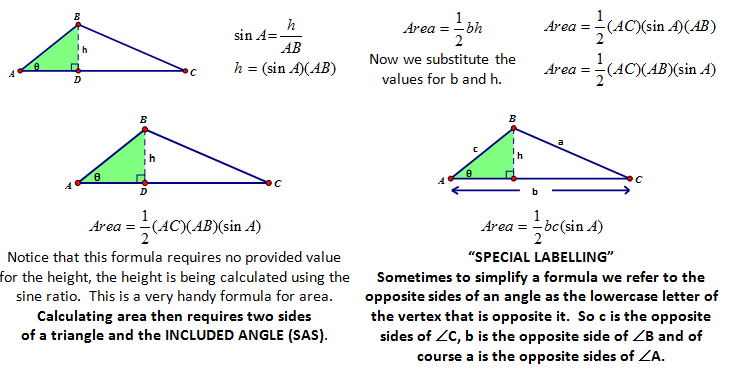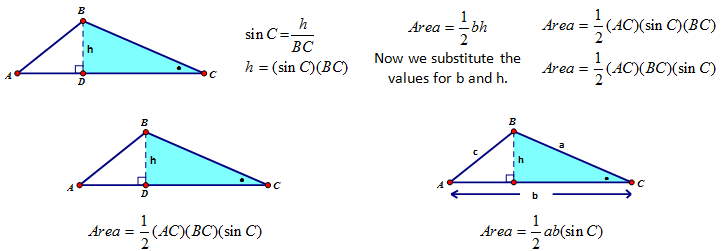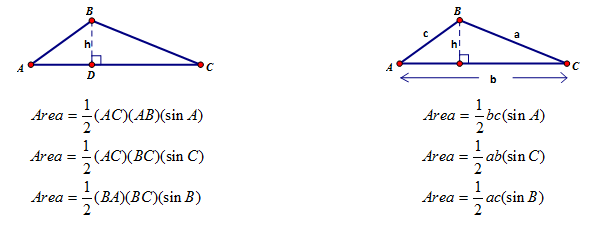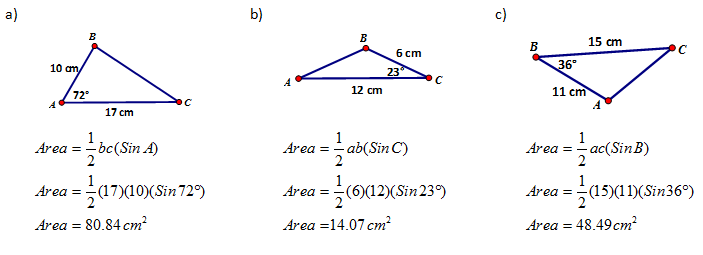CONCEPT 1 – Derive the formula A = 1/2 ab sin(C) for the area of a triangle by drawing an auxiliary line from a vertex perpendicular to the opposite side.
This objective is quite direct. Most objectives thus far leave something for us to interpret but here it is simply stated – Derive the formula for area using sine.
So far all of our trigonometry work has been in right triangles but the next three objectives introduce the use of trigonometry to solve for sides, angles and areas of all triangles, including the OBLIQUE TRIANGLES. An oblique triangle is a non-right triangle.
So then how do we use the sine ratio to solve for the area of a triangle?
To solve for the area of this triangle we would multiply ½ (base)(height) and in this case it would be ½ (AC)(BD) but the height is usually not provided when giving information about a triangle. So if we could create a formula for area that used only side lengths of the triangle it would be very helpful formula. By dropping the altitude (the height) to a side of the triangle we form a right triangle and this allows us to use our trigonometry ratios. Isn’t that tricky -- we know right triangle trigonometry and so we turn the oblique triangle into right triangles by dropping the altitude.
If we use the right triangle with ∠A we can use sine to solve for height (h).
This relationship works using any two sides of a triangle and their included angle, let’s now try the right triangle with ∠C.
The 3rd relationship angle, ∠B, works the exact same way but because the angle in this case is obtuse it requires a bit more thought.
| See the relationship when the angle is obtuse is always difficult for students to see. It is also here that we learn that sin b = sin (180 - b). This too is a little abstract for a geometry student who hasn't work with trigonometry on a coordinate plane. Slow down here.... |
Now you might have noticed a little ‘slight of hand’ maneuver with the calculation of height here. Because the height for the obtuse angle was outside of the triangle we could not use ∠B, we needed to use its supplement, 180 - m∠B. Not only did we do that but we also made a substitution from 180 - m∠B to m∠B…..? What?? Let see if I can explain this ‘Math Magic’……. Why can I say that 180 - m∠B = m∠B?
To understand this, we need to move geometry onto the coordinate plane.
Notice that the 68° right triangle and the 112° (180 – 68) create identical triangles except that the x values are opposites of each other (one positive and one negative). These two triangles are a reflection of each other (over the y axis). Both triangles use the same value for the opposite side and the same value of the hypotenuse. Both of these sides also share not only the same measurement but also the same positive/negative values. This means that the sine 68° and sine 112° (180 – 68) will always create the value.
Let us look at another example of this relationship.
Notice that the 20° right triangle and the 160° (180 – 20) create identical triangles except that the x values are opposites of each other (one positive and one negative). These two triangles are a reflection of each other (over the y axis). Both triangles use the same value for the ‘opposite’ side and the same value of the hypotenuse. Both of these sides also share not only the same measurement but also the same positive/negative values. This means that the sine 20° and sine 160° (180 – 20) will always create the value.
Try it out using your calculator:
This was a bit of an aside topic to help you understand that the following relationships work for all triangles and all angles in those triangles.
Here are a few examples of how to use this formula…. Determine the area of the following triangles.
|










